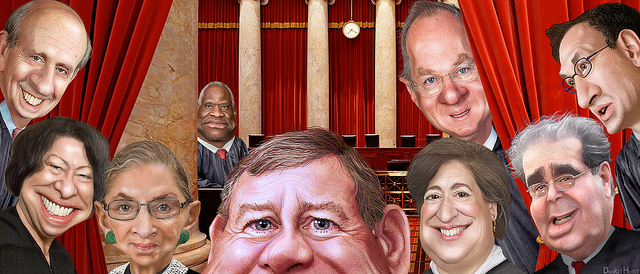So What Did We Learn About the Roberts Court?

By Dr. Herny Flores, NewsTaco
The current session of the Supreme Court (SCOTUS) has ended with a great deal of disappointment and joy, depending upon whose side you are on. I’m disappointed. But then again, it’s not the first time I have been disappointed in this institution. After all, they are lawyers!
Now that I got that out of my system, let’s take a serious look at what we learned from this SCOTUS session. The session itself was important to Chief Justice Roberts because he is trying to build his legacy. He is still young and he will be around for a long time, nevertheless, this was an important session because some very important cases were rendered that give a clear indication as to how legal historians and the public will think of and remember the Roberts Court, particularly Latino voters.
As far as general legal principles are concerned I think this court will be remembered as one that will look more favorably on state sovereignty than other courts have. This was clear in both the Voting Rights and DOMA decisions.
In the Voting Rights case SCOTUS found that Section 4 of the Voting Rights Act of 1965 was unconstitutional. The court could’ve struck down Section 5, the preclearance requirement, but instead decided, very craftily, to declare the formula that triggers Section 5 as outdated and not applicable to contemporary political times and situations. Frankly, SCOTUS did have a good point to a certain extent because some of the voter qualifications that were listed as violating Section 4 included literacy tests. Regardless, this decision left the “door open” so any local jurisdiction can now make any change in their election system without having to worry about “the Feds looking over their shoulders.” Rather than striking down Section 5, SCOTUS left it intact, but struck down which jurisdiction should be covered and why they needed to be covered by the law. So, we have a Section 5 covering no one.
I haven’t discussed this part but SCOTUS partially made their decision by looking at African American voter registration and turnout rates in the southern states that were covered under Section 5. How come SCOTUS didn’t look at Latino turnout and registration rates? What are we? Don’t we have the right to vote? Were we not covered by the law? SCOTUS in all its supremacy failed to look at a large body of evidence before they decided. Or, perhaps they just ignored the facts.
Asi, Justice Beto, part of your legacy for the Latino community will be that you didn’t even bother to think about us when you made important decisions! Instead you left us without any legal protections in voting anyway, and at the mercy of racists like the Little General in Texas. Bueno vato vamos ver que pasa.
Another part of the Roberts legacy will be that it will “narrowly tailor” its decisions. Well, ¡es la verdad! The court is narrow-minded. In the voting rights case by declaring Section 4 unconstitutional SCOTUS took a narrow position. It only ruled Section 4 unconstitutional and insured that the only folks who enjoyed protection in the voting booth were middle aged white people. SCOTUS literally narrowed the pool of eligible voters by lifting protections for African-Americans, Latinos, Asian Americans, Indians, the young, elderly and low-income folks. Hmmm, this list sounds awfully Democratic if you ask me. Naaaah! The Supreme Court would never issue a blatantly political decision, would it (Bush v Gore)?
SCOTUS also took a “narrow”-minded view of affirmative action when it ruled in the University of Texas case holding that the lower court, Fifth Circuit Court of Appeals in New Orleans, needed to re-look at the case to insure Texas was not placing too strong an emphasis on “race” as a qualification for entering freshmen. Already, “UT” is doing this by reducing their 10% Plan down to a 7% Plan for next year in order to manage the large number of applicants.
There were other cases decided by SCOTUS, obviously; striking down DOMA for instance – even this was rather narrow, but I don’t have room to visit all of them here.
What I did conclude from this term, and I gave Justice Roberts a great deal of room before the session closed, which I will not do any more, is that the Roberts Court has a 5-4 conservative/Republican/right-wing/ideologically bent majority. We should not expect much from future Roberts Court decisions other than further reduction of constitutional protections for groups who have been historically discriminated against. What the court did this term was open the “flood-gates” to a return to an era that gave birth to the Civil Rights Movement. So, me parese que we have to start all over again, lobbying, marching, getting thrown in jail, just to get this nation to the point where we have to right the Supreme Court’s wrongs.
[Photo by DonkeyHotey]
